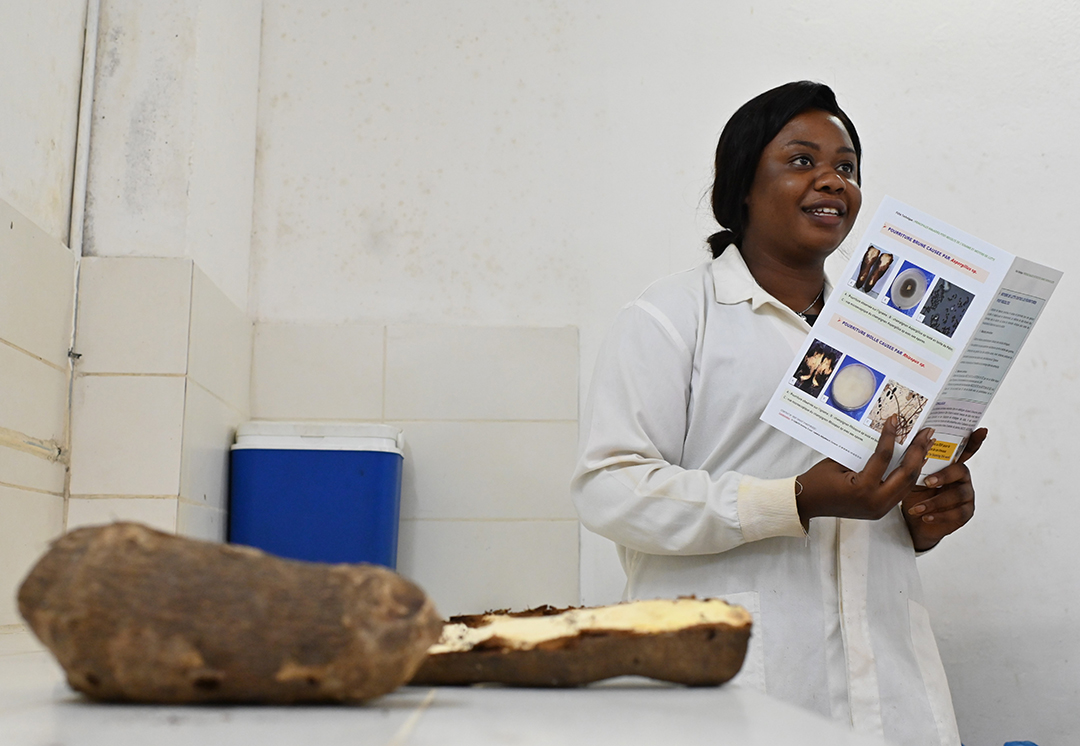Working class women laboured during the first industrial revolution for lower wages than men and they often started working as children. Women also had to be the caretaker of the house, so they might have worked all day and night to keep up their daily routines. Now, women continue to play a vital role in the fourth industrial revolution and gender inequalities still prevail.
International Women’s Day is celebrated annually on 8 March with the aim of upholding women’s achievements, recognising the specific challenges they face and to focus greater attention on women’s rights. The theme for International Women’s Day this year is DigitALL: Innovation and technology for gender equality.
Almost everything currently goes through a digital process, increasing the dependency on strong technological integration. Although women account for over half of the world’s population, 259 million fewer women have access to the internet than men.

Adjata Kamara, an award-winning PhD student in sustainable agriculture, biodiversity and climate change, at the Felix Houphouet-Boigny University Pole in Bingerville, near Abidjan, on October 28, 2022. In Africa, there is a great need for women in the STEM fields. Photo: Issouf SANOGO/AFP
While the digital revolution brings the immense potential to improve social and economic outcomes for women, it also poses the risk of perpetuating existing patterns of gender inequality. Despite several important initiatives, interventions and policies aimed at furthering women’s empowerment and gender equality within this revolution, a significant digital gender gap remains, limiting the equitable realisation of the benefits of digital transformation across all income countries.
The digital skills gap in the education sector can lead to the encoding of gender biases in technology, creating the need for education technologies to overcome this and eradicate the masculine stereotypes within science, technology, engineering and mathematics (STEM) fields.
With so many women unable to access the internet, they are prevented from developing the necessary digital skills to engage in digital spaces, which limits their opportunities to pursue careers in STEM-related fields. By 2050, 75% of jobs will be related to STEM areas, yet at present only 22% of employment opportunities in STEM fields are held by women.
This changing work environment has a potentially negative effect on women, including an increasing scarcity of jobs and “masculine defaults” within tech workplaces, as well as the under-representation of women in technical fields — all of which will amplify the gender bias in the digital space.
Digital technologies continue to rapidly transform society, simultaneously allowing for unprecedented advances in the human condition and giving rise to profound new challenges. Growing opportunities created by the application of digital technologies are, however, paralleled by stark abuses and unintended consequences.
Alongside the successful implementation of various technologies over the years, new risks and challenges related to fairness and inclusion, data privacy and autonomy, accountability and transparency as well as safety have become increasingly clear. For example, according to the Gender Snapshot 2022 Report, a study of 51 countries revealed 38% of women had personally experienced online violence.
The hurdles of the widening digital gender divide include a lack of education as well as inherent biases and socio-cultural norms located within existing masculine power structures that curtail women and girls’ ability to benefit from the digital revolution. In Saudi Arabia, for example, the Absher App has been used by men to track and control women’s movements, reinforcing the country’s system of male guardianship over women.
Additionally, it is important to understand the role played by sociocultural influences in the digital gender divide.
In India, around one-fifth of women were found to believe that the internet was not appropriate for them, for a number of cultural reasons. Around 12% of women report not using the internet because of the negative social perception associated with its use, and 8% due to the lack of acceptance by family members. Such hurdles can range from lack of support to outright discouragement or even prohibition.
None of this is to suggest that the digital revolution has not had its share of positive implications for women. Early feminist responses to the revolution were largely optimistic about the potential of digital technologies — particularly information and communication technologies (ICTs) — to empower women and transform gender relations.
Cellphone technologies have been particularly beneficial to women in increasing their access to information and facilitating collective action.
Several initiatives and projects that focus on access to technology have been implemented to advance women’s digital empowerment. Acknowledging the wide-ranging potential of digital technologies, the sustainable development goals (SDGs) pledged to “enhance the use of enabling technology, in particular information and communications technology, to promote the empowerment of women” (Goal 5b).
Aspiration 6 of Agenda 2063 calls for “an Africa, whose development is people-driven, relying on the potential of African people, especially its women and youth, and caring for children”.
The AU recognises that gender equality is a fundamental human right and an integral part of regional integration, economic growth and social development and has developed the AU’s strategy for Gender Equality and Women’s Empowerment (GEWE) to ensure the inclusion of women in Africa’s development agenda.
Pillar one of the GEWE strategy focuses on “maximising opportunities, outcomes and E-TECH dividends.” According to this pillar, for women to be economically empowered, and contribute to sustainable development, they must have equal access to quality education and control over productive resources.
The UN Women, in partnership with the African Union Commission (AUC) and the International Telecommunication Unit (ITU) implemented the African Girls Can Code Initiative (AGCCI) to train young women in critical coding and tech skills. The initiative aims to train a minimum of 2 000 girls aged 17-25, setting them up for futures as computer programmers, creators and designers. AGCCI has developed a guide on mainstreaming ICT, gender and coding in national curricula across the continent, launched an eLearning platform and hosted a series of webinars to keep the learning going during the Covid-19 pandemic.
Closer to home, Good Governance Africa in association with The Telkom Foundation held an ICT workshop in Centurion, Gauteng, to highlight the advancements and careers available to girls within the digital space and STEM fields.
The ability of women to access and use digital technologies is directly and indirectly affected by market-related factors including investment dynamics, regulations and competition, especially in rural areas.
These areas are often marginalised and the investment and installation of infrastructures, such as broadband and cell phone towers, is often less economically profitable for service providers — due to the low population density in those areas. According to UN Statistics, this can disproportionately affect women in developing countries as they seem to be more often located in rural areas, whereas working-age men tend to be mainly in urban areas.
Women and girls in rural areas of developing countries further face persistent structural constraints, including their higher probability to be out of school than boys — this likelihood is twice as high as girls in urban areas.
Furthermore, women and girls in rural areas often generally work in agriculture (subsistence farming) and their work is often unpaid or considered a contribution to the family. UN Women Watch highlights that, when employed, women in rural areas tend to have shorter-term and more precarious jobs and are generally less protected than men This translates to being confined in technology-poor environments where it is difficult, if not impossible, to use digital technologies, and into having scarce resources, particularly financial ones, to enable going online.
In bridging the digital gender gap, there is a pressing need for concrete policy reform to advance the progress of women’s rights within the digital society, particularly in developing countries and in marginalised and rural areas.
The design and implementation of national digital strategies that actively aim at closing the gender digital gap — and enhancing the affordability of digital technologies at the same time as increasing online safety — are vital measures to be taken.
Chrissy Dube is the Chairperson of the GGA Management Committee and also a member of the GGA Executive Committee. She is Head of Governance Insights and Analytics at Good Governance Africa. She completed her Master of Commerce Degree at the University of KwaZulu-Natal in 2013. She also has qualifications in Advanced Project Management, Data Analysis, Ethics, and Compliance. With her experience in interrogating data, Chrissy specialises in analysing and interpreting data for informed decision-making in both the private and public sectors. Chrissy is a registered member of the Institute of Risk Management South Africa. Her interests include monitoring economic and social developments.







